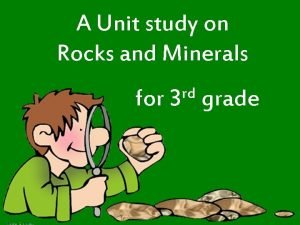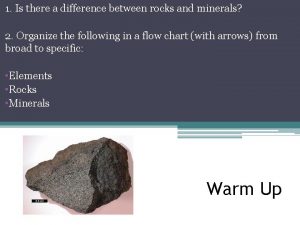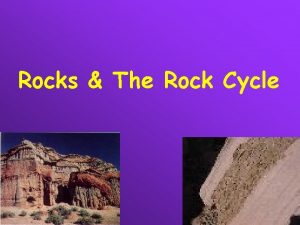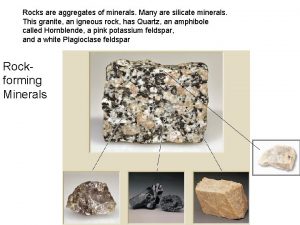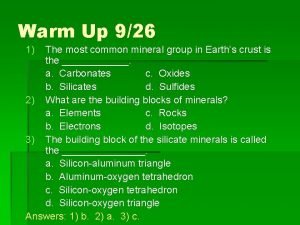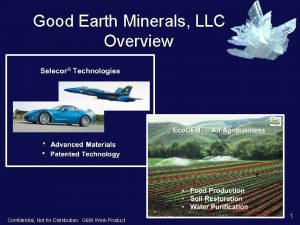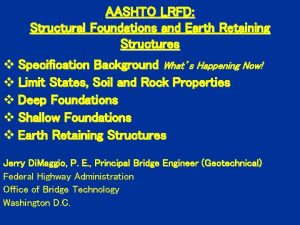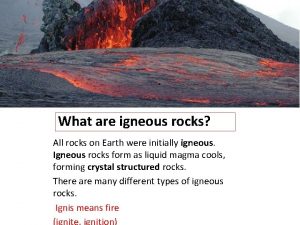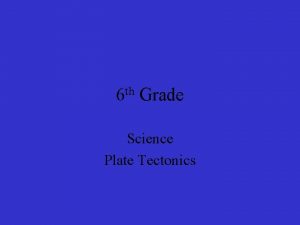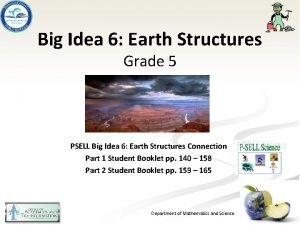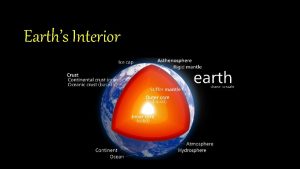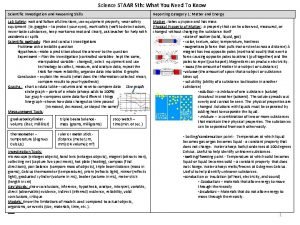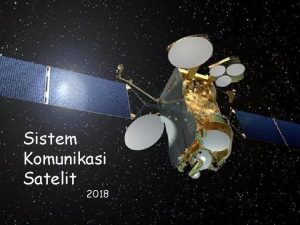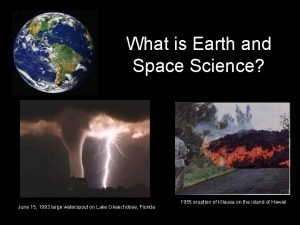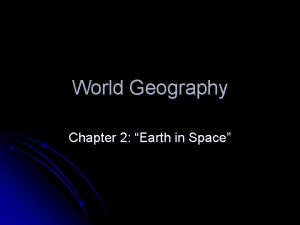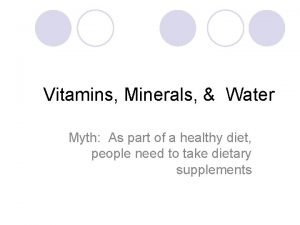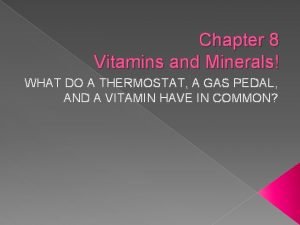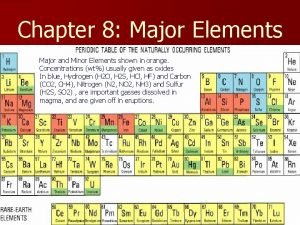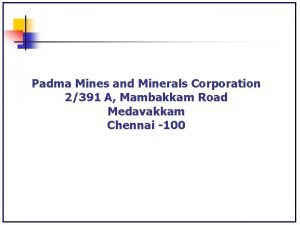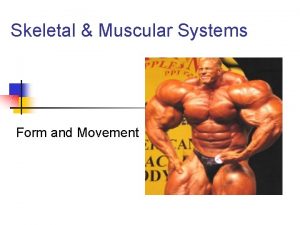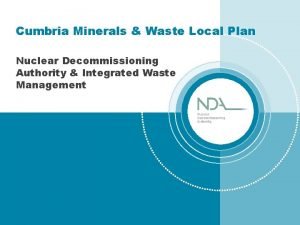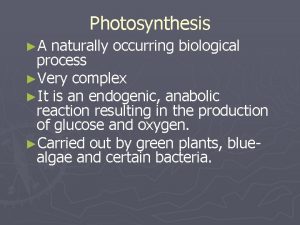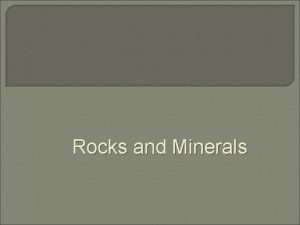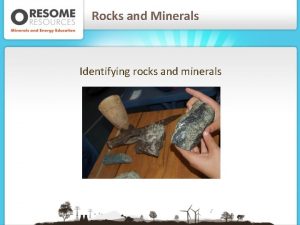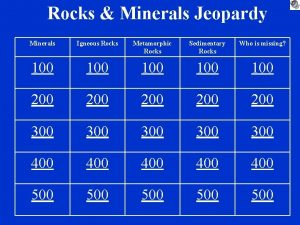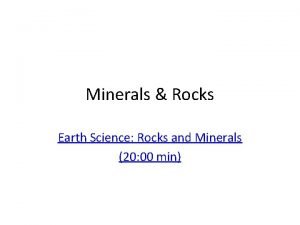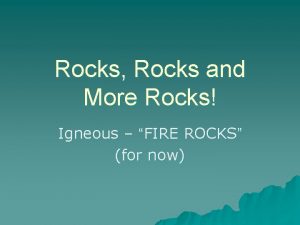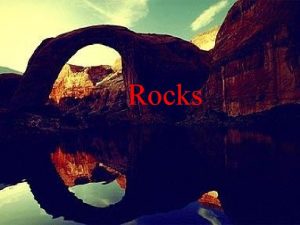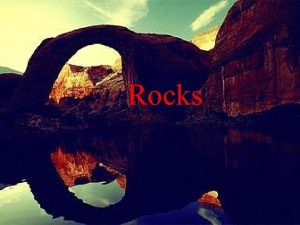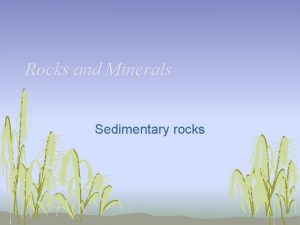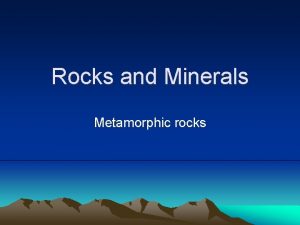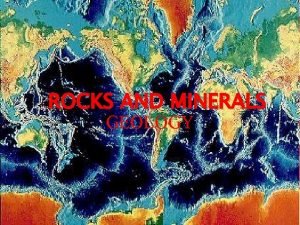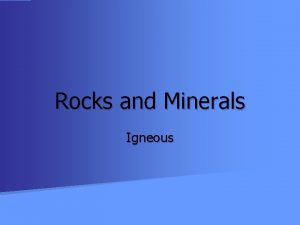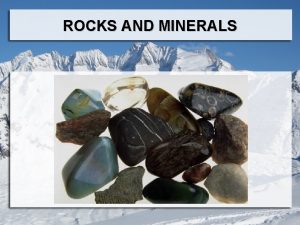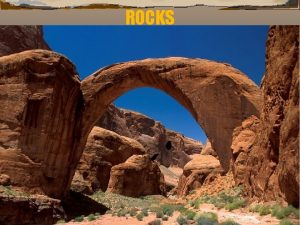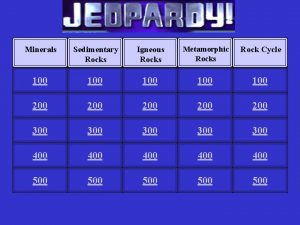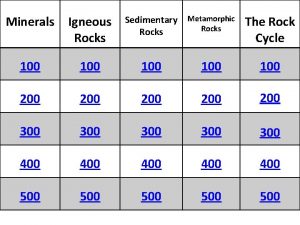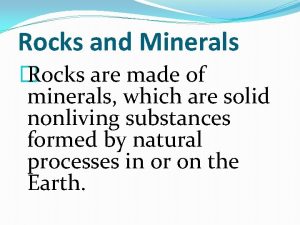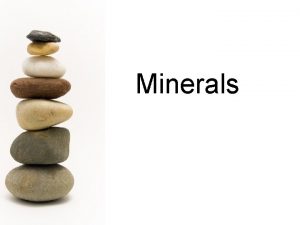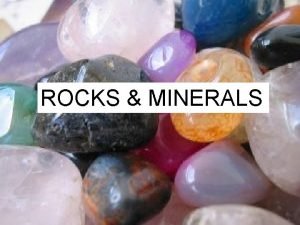EARTH AND SPACE Minerals Rocks and Structures Minerals











































- Slides: 43

EARTH AND SPACE Minerals, Rocks, and Structures

Minerals, Rocks, and Structures Types of Minerals Stone throughout time age: Tools Bronze Iron age: Bronze age: Tools Today: Multiple ways

Mineral characteristics Must have all 5 characteristics Solid Inorganic All natural Definite Regular composition 3 D arrangement of atoms called a Crystal structure

Rocks Naturally occurring Can consists of 1 mineral Most contain several minerals Rocks that contain valuable minerals are called ores To remove these mineral ores must be mined in 2 ways: Surface Underground

Granite and Basalt Granite Consists of fieldspar, quartz, and mica Basalt Consists of fieldspar and pyroxene

Mineral Identification Properties Hardness Luster Streak Color Magnetized Cleavage

Mineral Characteristics Hardness The resistance of a mineral to scratching Scale of hardness is called the Mohs scale

Luster The way a mineral reflects light Metallic waxy) (looks polished) or non-metallic (glassy or

Streak Color of powdered mineral Determined by taking a mineral and scratching across a tile

Specific Gravity Ratio of the weight of the mineral to the weight of an equal volume of water

Cleavage The breaking of a mineral along regularly oriented planes of weakness Planes occur along weak atomic bonds

Crystal shape Minerals that grow in unconfined spaces usually have a regular crystal shape

Color First noticeable trait Least reliable Different impurities depend on what impurities are present

Other Properties Malleability Conductors Reaction of electricity to acids Radioactivity Magnetism Fluorescent

Igneous Rocks and our Community

Nature of Igneous rocks Rocks that solidified from molten or partly molten material that is from magma All are made of interlocking crystals of minerals Resistant 6 to weathering and erosion common igneous rocks Basic structure is made of Si and O

Magma, Lava, and Igneous Rocks Earth’s temperature initially rises about 30 degrees C each km Due to temperature increasing with depth, rocks begins to melt into magma, when some rocks begin to cool and solidify from the magma it forms a new formation called Intrusive Igneous Rock Magma that reaches the earth’s surface is called Lava Extrusive Igneous Rock is rock that is formed from lava cooling

Classifying Igneous Rocks Texture Crystal size depends on how quickly magma cools Slower cooling magma allows only a small number of crystals to form Texture Fast becomes coarse grained cooling magma allows a large number of crystals to form Texture Faster becomes fine grained cooling magma forms a glassy textured rock called Obsidian Forms when magma cools so fast crystals do not have time to form

Classifying Igneous Rocks Chemical and Mineral Composition Color is due to chemical makeup (depends on what minerals rocks contain) Light color Quartz, Potassium, Feldspar, and Muscovite Mica Contains Contain Dark a lot of Si and O little Fe and Mg color Pyroxenes, Olivines Rich in Fe and Mg Typically Mixed Amphiboles, Plagioclase Feldspar, Biotite Mica, and Black and green

Classifying Igneous Rocks Explosive Volcanic Eruptions Results in ash

Sedimentary Rocks and your Community

Distribution of Sedimentary Rocks Earth surface is made of: Thin layer of soil and young sediments Sediment: solid fragments or particles that are transported and deposited by wind, water, or ice Earth’s crust is made of: Solid bedrock Bedrock: solid rock that is connected continuously down into Earth’s crust, rather than existing as separate pieces or masses surrounded by loose materials Most common type of rock in the upper crust are Sedimentary Rocks Usually layered that results from the consolidation of lithification of sediment Covers 3/4 th of the top of the earth’s crust

Distribution of Sedimentary Rocks Clastic Sedimentary rocks Made up mostly of fragments derived from pre-existing rocks and transported mechanically to their places of deposition Fragments are called clasts Clasts are individual fragments of sediments produced by the physical disintegration of a larger rock mass Silt Shale Sandstone Conglomerate

Distribution of Sedimentary Rocks Chemical Sedimentary Rock Precipitation Chemical Sedimentary rocks formed by direct chemical precipitation of minerals from a solution. Consists of materials that have precipitated from ocean water or lake water Most common is Limestone

Distribution of Sedimentary Rocks Organic Sedimentary Rock Organic sedimentary rocks are organic materials. Consists mainly of the remains of organisms Best Coal example is Sedimentary Environments Forms from sediments that are deposited in various places at Earth’s surface

Distribution of Sedimentary Rocks Sedimentary rocks and Climate Sediment creation Produced through compaction and cementation Classifying Sedimentary Rocks

Metamorphic Rocks and your Community SEC. 4

Formation of Metamorphic Rocks: Rock that can be changed into a different rock type without actually melting. Must have high temperatures and pressures Process is called metamorphism Occurs when rocks are still solid Studied in labs by using special furnaces Temperature Buried Body of rocks can be increased in two ways: deeper in Earth of magma passes near the rock

Metamorphic Rocks Deformation in Metamorphism Foliation in Metamorphic Rocks Common Some contain a high percentage of fine flaked mica minerals Foliation during Regional Metamorphism

Protoliths of Metamorphic Rocks Rock formed from metamorphic rocks are called protoliths

Rock Units and Your Community

Rock Units Number of rocks on Earth’s crust varies greatly Generally Rock the same rock over large areas Units Contact

Sedimentary Rock Units Early units believe to be laid down like “layered cake” Current layout varies Identify them based on 2 ways Name of place in which they were found Name of formation

Igneous Rock Units Formed in 2 ways Cooling and crystallization of magma Volcanic Units activity vary in shape and size Sills Dikes Batholiths

Metamorphic Rock Units Shape is more complex than others Change of shape usually takes place during folding and faulting

Structural Geology in your Community

Types of Forces Previously believed that rocks were laid down in layers Folds- usually formed when rocks are squeezed together by compression forces Forces cause rocks to fracture then slip along the fracture surfaces The fracture surface along which rocks slips is called a fault Forces within earth cause folding and faulting Plates move very slowly 2 -20 cm/yr

3 Types Forces 1. Tension- Force that tends to pull material apart 2. Compression- Force that tends to push material together 3. Shear- Force that tends to make two masses of material slide past each other In all 3, the forces is greater than the strength of the material Will deform by fracturing or changing shape without breaking Forces are created by the movement of lithospheric

Folding and Faulting Determined partly by temperature At lower temperatures the rocks located in Earth’s upper crust are more brittle tend to deform by fracturing Force exerted on rocks at high temperatures tend to continuously change shape without breaking Folded or faulted rocks also occurs over time Forces build quickly then causes a fracture that build up slowly change their shape without breaking

Faults Can be formed by tension force Body of rock above the fault plane slides down relative to the body of rock below the fault plane Called The body of rock above the fault plane slides upward relative to the body of rock below the fault plane Called Normal Faults Reverse Faults When a fault plane is nearly horizontal, reverse faults are called thrust faults Called Thrust Faults

Faults When a fault is formed by horizontal shear forces, the bodies of rock on either side of the fault plane slide past each other horizontally is called Strike-slip faults Movements usually occur suddenly after a long time without movement Most earthquakes are caused by sudden movements on faults

Folds Common when the rock is layered and the layers differ in stiffness (resistance to being bent) Usually arranged horizontally Parts of the folds that are concave upward are called Synclines Parts of the of folds that are convex upward are called Anticlines Can be as small as centimeters or as large as kilometers

Molds to Investigate Folding rocks cannot be seen in nature as it happens Scientists use layers of colored wax and a special squeeze box
 Sedimentary rock song
Sedimentary rock song Igneous rock to metamorphic rock
Igneous rock to metamorphic rock What type of rock is this
What type of rock is this Difference between minerals and rocks
Difference between minerals and rocks Difference between minerals and rocks
Difference between minerals and rocks Concept map rocks and minerals
Concept map rocks and minerals Poem about minerals and rocks 3 stanza
Poem about minerals and rocks 3 stanza Difference between rocks and stones
Difference between rocks and stones Rocks and minerals
Rocks and minerals Rock vs mineral
Rock vs mineral Rocks are aggregates of minerals
Rocks are aggregates of minerals Extrusive rocks and intrusive rocks
Extrusive rocks and intrusive rocks Andesite vs granite
Andesite vs granite Homologous
Homologous Most abundant minerals in earth's crust
Most abundant minerals in earth's crust Good earth minerals
Good earth minerals Foundations and earth retaining structures
Foundations and earth retaining structures Igneous rock formation
Igneous rock formation Breaks in earth's crust where rocks slipped past each other
Breaks in earth's crust where rocks slipped past each other Urban space and structures
Urban space and structures Big idea 6 earth structures
Big idea 6 earth structures Structures of the earth
Structures of the earth 8th grade science staar review reporting category 4
8th grade science staar review reporting category 4 Arsitektur sistem komunikasi satelit
Arsitektur sistem komunikasi satelit Space scientific definition
Space scientific definition This insulates our earth from the deep cold of space
This insulates our earth from the deep cold of space Earth's role as a body in space
Earth's role as a body in space Space art lesson
Space art lesson Chapter 2 the earth in space answers
Chapter 2 the earth in space answers Joint space vs cartesian space
Joint space vs cartesian space Space junk the space age began
Space junk the space age began Camera space to world space
Camera space to world space Unscented trajectory chapter 5
Unscented trajectory chapter 5 World space computer
World space computer Minerals and their functions sources and deficiency chart
Minerals and their functions sources and deficiency chart Chapter 8 vitamins and minerals
Chapter 8 vitamins and minerals What are the elements of major and minor minerals
What are the elements of major and minor minerals Absorbs water and minerals
Absorbs water and minerals Padma mines and minerals corporation
Padma mines and minerals corporation Stores minerals and anchors muscles
Stores minerals and anchors muscles Cumbria minerals and waste local plan
Cumbria minerals and waste local plan Resources that can be replaced
Resources that can be replaced Minerals and fuels
Minerals and fuels Vitamins sources functions and deficiency chart
Vitamins sources functions and deficiency chart




